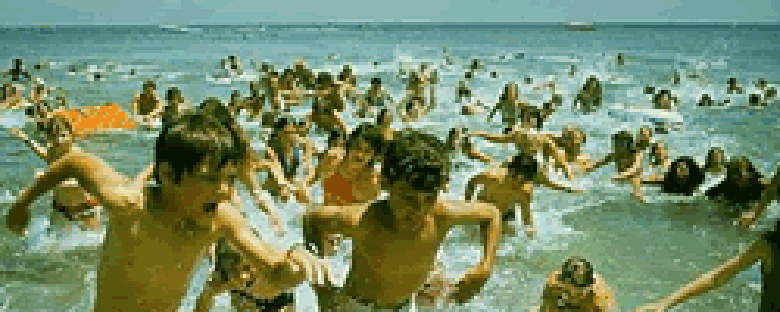Reviews
Steven Spielberg
USA, 1975
Credits
Review by Rumsey Taylor
Posted on 11 July 2004
Source Universal Studios DVD
Midway through Jaws, the film’s vulnerable locale — Amity Island — is celebrating the Fourth of July, the town’s most popular and commercialized holiday. A montage finds American flags strewn in most any direction as well as ferries delivering their capacity of tourists. At Amity, the Fourth garners attention and consistent commercial prosperity. It is a popular American attraction and mirrors Jaws’ contextual significance as the arrival of an inherently American cinematic trend.
Prior to Jaws film studios were generally prolific, producing dozens of pictures annually each with viable, affordable, and riskless budgets. Afterwards, studios would risk their worth on a handful of pictures, and in some cases a single one. Though Jaws’ position as the very fulcrum to the increasing commercialization of cinema is debatable, it is clear, generally, that it represents the birth of the studio blockbuster.
Jaws’ famous opening death has been emulated numerously; although there are previous examples of a prolonged unveiling of a title killer, Jaws’ opening is arguably the most referenced and used. It is of little debate, as its formula has become a facsimiled equation for profit, of which the opening is the preeminent, telling feature.
The film is a straightforward, visceral escapist entertainment with little capacity for interpretation. As David Cook attests (in A History of Narrative Film), Jaws and other early blockbusters are “technically polished, but so calculated in terms of effect that they have all the predictability of a Big Mac hamburger.” Cook’s assessment is correct, though the trait is of no objective fault, for the film’s generic narrative is complimented invaluably by restraint, suggestive direction and scoring.
As an apt example of the film’s restraint, the arrival of scientist Matt Hooper is urged by a study of the first female victim. It is an especially harrowing and suggestive sequence. He narrates her autopsy, and the view centers closely on his face; his stifled gags and short breath punctuate the horror. Significantly, the body is never seen until the victim’s severed, swollen arm is raised and appears unattached to the body. Had she been eaten whole the scene would have neither suspense nor suggestion. The remaining, chewed-up half relays more effectively the speed, efficiency, and menace of its killer.
Prior to the first sight of a telltale dorsal fin, the shark is creatively visualized in the throes of its victims, a dock it manages to dissect, and yellow, air-filled kegs. This visual absence of the title killer may be attributed to the sparing use of the malfunctioning animatronic shark designed for the film, though this absence during the first hour benefits the film’s suspense.
Because of the variety, frequency, ease, and horror of the attacks, the shark’s threat is tangible. As with Psycho and (I would attest) The Blair Witch Project, Jaws has induced a collective fear arguably more known than the film itself. This threat, in turn, is integral to evaluating Chief Brody’s role as the film’s hero. He is a representative of the law, the town sheriff, respected and fulfilled by his diminutive responsibility (his introduction is followed by his task to construct “Beach Closed” signs). As a protagonist he is flawed, reasonable and easily swayed, unfamiliar with the extent of his authority because it is rarely challenged. He is a vulnerable father — a hero trademark in Steven Spielberg films — who overcomes his great fear of water only when his family has been threatened; he is a patriarch who leaves home only to protect his nest. This protective impulse is commonly understandable, and it is Brody’s distinguishing heroic trait.
Brody during the film’s final hour (a stalwart example of characterization) is grouped with a fisherman, Quint, and scientist, Hooper. The three are masculine archetypes: the rational father, workman, and materialistic academic, among numerous other character dialectics. Each has beneficial and detrimental traits, as well as a collective incompatibility, and each is instrumental in combating the threat. There is the distinct suggestion, although the shark’s final death is due to the actions of one of them, that their collaboration fosters their success. Hooper is armed with wealth and gadgetry; Quint, his opposite, possesses calloused hands and grit. Brody is the most able of the three as his position as a father affords him the knowledge of the value of life. Thusly, he is armed with a vengeance unavailable to the other two. He is the only one who has been justifiably threatened by the killer shark, and his fear is integral to his strife in battling it; it is respect, an acknowledgement of power necessary in appropriately downing the opposed “miracle of evolution.”
We don’t do comments anymore, but you may contact us here or find us on Twitter or Facebook.



